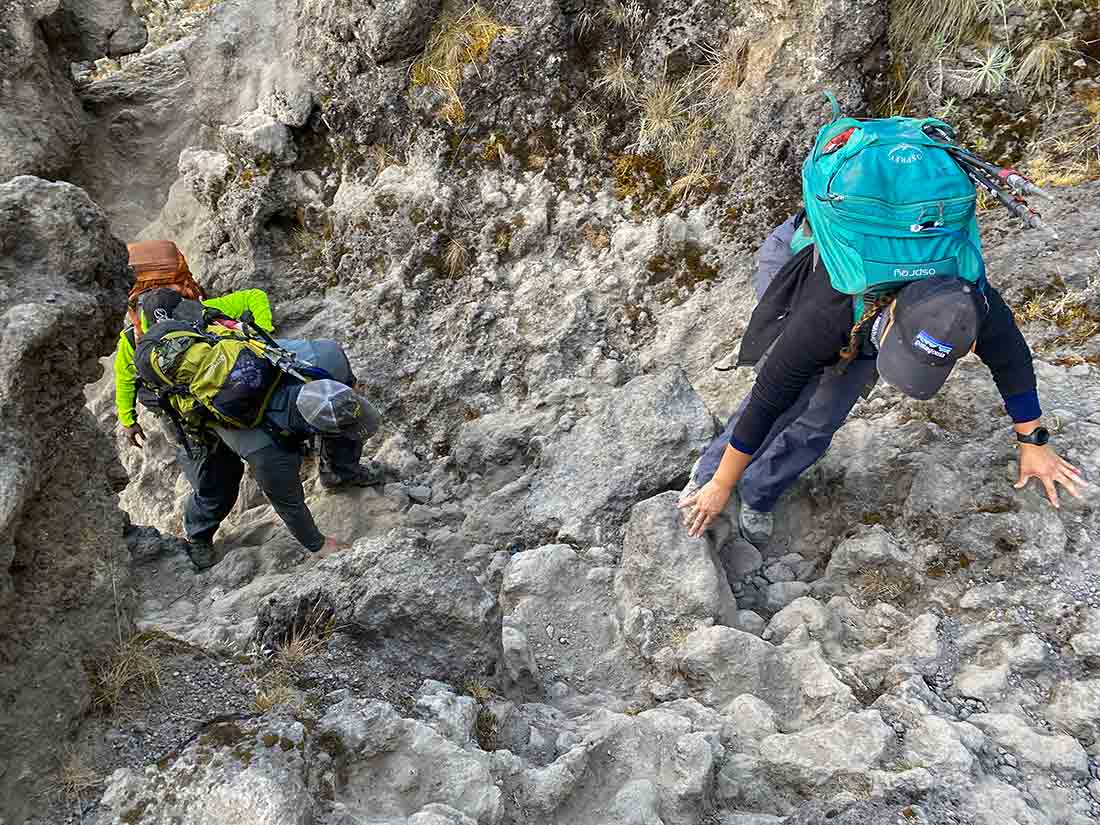Mount Kilimanjaro is the highest mountain in Africa. Getting to the peak takes several days. You increase elevation from the start to the summit faster than going to Everest Base Camp. It is much more difficult than you think. However, reaching the summit is much easier if you do your research, have the right gear, and train for Kilimanjaro.

It is essential that you train for Kilimanjaro. Science has not specifically pinpointed the cause of altitude sickness, but being fit will definitely reduce the wear and tear on your body as you ascend Kilimanjaro. This will reduce the stress on your body and in turn allow you to better adapt to the extreme elevation.
Most of our clients have never hiked for so many consecutive days at such high elevations. We strongly encourage you to be in great shape. The daily hike is at a slow pace and most days end in the early afternoon, however, the combination of physical activity, lack of sleep, poor appetite, dehydration, weather, and elevation are working against you. As you ascend toward the summit, your physical and mental aptitude will be tested.
We recommend training a minimum of eight weeks before your climb. 12 weeks is better. You may require more or less depending on your current fitness and your hiking skill. Keep in mind that hiking should be the focus of your training. Hike as much as you can. It is much more effective than weight training.
Altitude sickness can happen to anyone, but being physically fit makes it easier to summit. Why is that, you ask? Because your body will struggle less and recover quicker allowing you to adapt to the extreme elevation gain.
Furthermore, the fitter you are, the less of a mental challenge climbing Kilimanjaro will be. You’ll be more confident and that swagger will give you that “I Got This” attitude.
Train for Kilimanjaro
First of all, hiking is the best way to get better at hiking. The type of fitness is more important than the degree of fitness. Climbing Kilimanjaro is a hike, therefore the best preparation one can do is to hike, preferably under simulated conditions. Running is beneficial to your fitness level, however, it does not fully prepare your muscles for a strenuous multi-day hike.

As an example. I’ve hiked 38 miles with more than 10,000 feet of elevation gain in Grand Canyon on the Royal Arch Loop. I did a side trek rappelling through Royal Arch and down to Elves Chasm as well. I was fine. I had trained for it. One week later I did a 6-mile “Mud Run” and could barely finish. There is a science behind Sport Specific training. Training for hiking Kilimanjaro is no different. If you’d like to know more about Sport Specific Training go here: http://www.purewinnipeg.com/sport-specific-training/
Train for Kilimanjaro Schedule
10-12 Weeks Before Your Climb
Make a training schedule and force yourself to do it each day. Your trip will arrive quicker than you expect.
Day 1: Hike or StairMaster for at least one hour
Day 2: Light leg workout with weights, cycling, or jogging
Day 3: Hike or StairMaster for at least one hour
Day 4: Rest
Day 5: Open day to do any exercise you like
Day 6: Hike or StairMaster for at least one hour
Day 7: Rest
Notes: For your hikes and StairMaster training wear a daypack with 8-10 pounds in it.
8 Weeks Before Your Climb
Build your foundation of strength and endurance. Try to keep workouts challenging and fun.
Day 1: Hike or StairMaster for at least one hour
Day 2: Moderate leg workout with weights
Day 3: Hike or StairMaster for at least one hour
Day 4: Rest
Day 5: Open day to do any exercise you like
Day 6: Hike at least three hours with a weighted pack
Day 7: Rest
Notes: Increase the weight in your daypack to about 20 pounds. At least once a week do a long hike of eight hours. Work in overnight backpacking so you get used to sleeping outdoors.
4 Weeks Before Your Climb
You have reached a month before your trip. Your workouts should be more intense. Increase the weight of your pack, hike faster, and challenge yourself.
Day 1: Hike or StairMaster for at least one hour
Day 2: Hard leg workout with weights
Day 3: Hike or StairMaster for at least one hour
Day 4: Light leg workout with weights, cycling, or jogging
Day 5: Open day to do any exercise you like
Day 6: Hike at least four hours with a weighted pack
Day 7: Rest
2 Weeks Before Your Climb
With two weeks to go, you should start to reduce your training to prevent injury. Now you just want to maintain your endurance and strength. Make sure to get as much sleep as possible to allow your body to recover before you begin your trip.
Day 1: Hike or StairMaster for at least one hour
Day 2: Light leg workout with weights, cycling, or jogging
Day 3: Hike or StairMaster for at least one hour
Day 4: Rest
Day 5: Open day to do any exercise
Day 6: Hike or StairMaster for at least one hour
Day 7: Rest
Before embarking on a fitness program, it is always wise to first seek the advice of a medical doctor. Feel free to share this program with your family doctor for input. Chances are, your doctor will be delighted to know that you undertake to exercise regularly.
Get a Workout Partner
What better way to get in shape than to get a workout partner. Book your climb with a friend or family member. Father’s day is coming up, why not give the gift of adventure and make some lasting memories by booking a Kilimanjaro climb for you and your father. Imagine how great that could be to train for Kilimanjaro and then climb it together.




